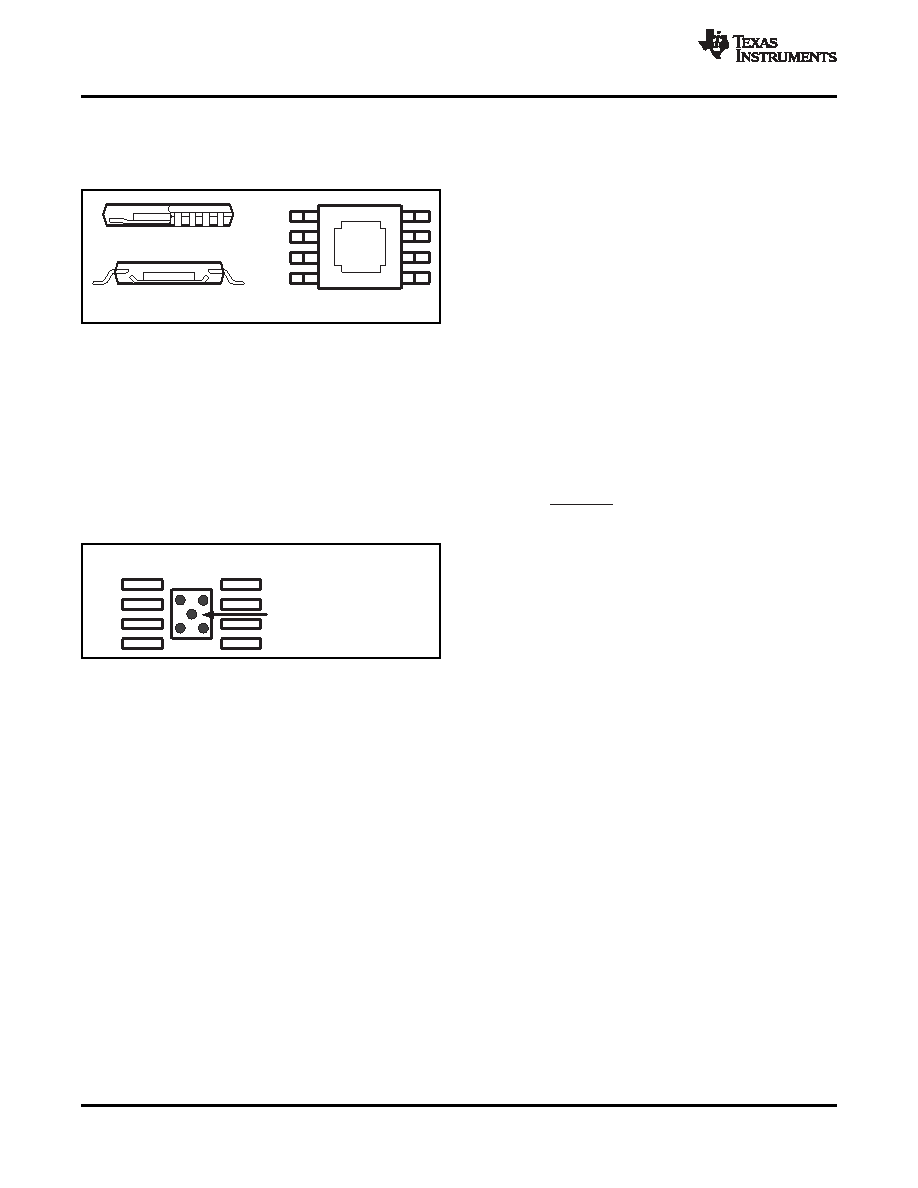- 您現(xiàn)在的位置:買賣IC網(wǎng) > PDF目錄98225 > THS4215DR (TEXAS INSTRUMENTS INC) 1 CHANNEL, VIDEO AMPLIFIER, PDSO8 PDF資料下載
參數(shù)資料
| 型號: | THS4215DR |
| 廠商: | TEXAS INSTRUMENTS INC |
| 元件分類: | 音頻/視頻放大 |
| 英文描述: | 1 CHANNEL, VIDEO AMPLIFIER, PDSO8 |
| 封裝: | GREEN, PLASTIC, SOIC-8 |
| 文件頁數(shù): | 21/47頁 |
| 文件大小: | 1197K |
| 代理商: | THS4215DR |
第1頁第2頁第3頁第4頁第5頁第6頁第7頁第8頁第9頁第10頁第11頁第12頁第13頁第14頁第15頁第16頁第17頁第18頁第19頁第20頁當(dāng)前第21頁第22頁第23頁第24頁第25頁第26頁第27頁第28頁第29頁第30頁第31頁第32頁第33頁第34頁第35頁第36頁第37頁第38頁第39頁第40頁第41頁第42頁第43頁第44頁第45頁第46頁第47頁

DIE
Side View (a)
DIE
End View (b)
Thermal
Pad
Bottom View (c)
P
D +
Tmax * TA
q
JA
where
PD = Maximum power dissipation of THS4211 (watts)
TMAX = Absolute maximum junction temperature (150°C)
TA = Free-ambient temperature (°C)
θJA = θJC + θCA
θJC = Thermal coefficient from junction to the case
θCA = Thermal coefficient from the case to ambient air
(
°C/W).
Single or Dual
68 Mils x 70 Mils
(Via Diameter = 13 Mils)
SLOS400E – SEPTEMBER 2002 – REVISED SEPTEMBER 2009 ................................................................................................................................... www.ti.com
The PowerPAD package represents a breakthrough
transfer. Therefore, the holes under the THS4211
in combining the small area and ease of assembly of
and THS4215 PowerPAD package should make
surface
mount
with
the
heretofore
awkward
their connection to the internal ground plane, with
mechanical methods of heatsinking.
a
complete
connection
around
the
entire
circumference of the plated-through hole.
6. The top-side solder mask should leave the
terminals of the package and the thermal pad
area with its five holes exposed. The bottom-side
solder mask should cover the five holes of the
thermal pad area. This prevents solder from
being pulled away from the thermal pad area
during the reflow process.
7. Apply solder paste to the exposed thermal pad
Figure 89. Views of Thermally
area and all of the IC terminals.
Enhanced Package
8. With these preparatory steps in place, the IC is
simply placed in position and run through the
Although there are many ways to properly heatsink
solder
reflow
operation
as
any
standard
the PowerPAD package, the following steps illustrate
surface-mount component. This results in a part
the recommended approach.
that is properly installed.
For a given
θJA, the maximum power dissipation is
PowerPAD PCB LAYOUT CONSIDERATIONS
shown in Figure 91 and is calculated by Equation 6:
1. Prepare the PCB with a top side etch pattern as
shown in Figure 90. There should be etching for
the leads as well as etch for the thermal pad.
(6)
The next consideration is the package constraints.
Figure 90. PowerPAD PCB Etch and
The two sources of heat within an amplifier are
Via Pattern
quiescent power and output power. The designer
should
never
forget
about
the
quiescent
heat
2. Place five holes in the area of the thermal pad.
generated within the device, especially multi-amplifier
These holes should be 13 mils in diameter. Keep
devices. Because these devices have linear output
them small so that solder wicking through the
stages (Class AB), most of the heat dissipation is at
holes is not a problem during reflow.
low output voltages with high output currents.
3. Additional vias may be placed anywhere along
The other key factor when dealing with power
the thermal plane outside of the thermal pad
dissipation is how the devices are mounted on the
area. They help dissipate the heat generated by
PCB. The PowerPAD devices are extremely useful
the THS4211 and THS4215 IC. These additional
for heat dissipation. But, the device should always be
vias may be larger than the 13-mil diameter vias
soldered to a copper plane to fully use the heat
directly under the thermal pad. They can be
dissipation properties of the PowerPAD. The SOIC
larger because they are not in the thermal pad
package, on the other hand, is highly dependent on
area to be soldered, so wicking is not a problem.
how it is mounted on the PCB. As more trace and
4. Connect all holes to the internal ground plane.
copper area is placed around the device,
θJA
5. When connecting these holes to the ground
decreases
and
the
heat
dissipation
capability
plane, do not use the typical web or spoke via
increases. For a single package, the sum of the RMS
connection methodology. Web connections have
output currents and voltages should be used to
a high thermal resistance connection that is
choose the proper package.
useful for slowing the heat transfer during
soldering operations. This resistance makes the
soldering of vias that have plane connections
easier. In this application, however, low thermal
resistance is desired for the most efficient heat
28
Copyright 2002–2009, Texas Instruments Incorporated
相關(guān)PDF資料 |
PDF描述 |
|---|---|
| THS4215D | 1 CHANNEL, VIDEO AMPLIFIER, PDSO8 |
| THS4215DRBT | 1 CHANNEL, VIDEO AMPLIFIER, PDSO8 |
| THS4215DGKR | 1 CHANNEL, VIDEO AMPLIFIER, PDSO8 |
| THS4215DGK | 1 CHANNEL, VIDEO AMPLIFIER, PDSO8 |
| THS4215DGKRG4 | 1 CHANNEL, VIDEO AMPLIFIER, PDSO8 |
相關(guān)代理商/技術(shù)參數(shù) |
參數(shù)描述 |
|---|---|
| THS4215DRB | 制造商:Rochester Electronics LLC 功能描述:- Bulk |
| THS4215DRBR | 功能描述:高速運(yùn)算放大器 Super-Fast Ultr-Lo- Distortion Hi-Speed RoHS:否 制造商:Texas Instruments 通道數(shù)量:1 電壓增益 dB:116 dB 輸入補(bǔ)償電壓:0.5 mV 轉(zhuǎn)換速度:55 V/us 工作電源電壓:36 V 電源電流:7.5 mA 最大工作溫度:+ 85 C 安裝風(fēng)格:SMD/SMT 封裝 / 箱體:SOIC-8 封裝:Tube |
| THS4215DRBRG4 | 功能描述:高速運(yùn)算放大器 Super-Fast Ultr-Lo- Distortion Hi-Speed RoHS:否 制造商:Texas Instruments 通道數(shù)量:1 電壓增益 dB:116 dB 輸入補(bǔ)償電壓:0.5 mV 轉(zhuǎn)換速度:55 V/us 工作電源電壓:36 V 電源電流:7.5 mA 最大工作溫度:+ 85 C 安裝風(fēng)格:SMD/SMT 封裝 / 箱體:SOIC-8 封裝:Tube |
| THS4215DRBT | 功能描述:高速運(yùn)算放大器 Super-Fast Ultr-Lo- Distortion Hi-Speed RoHS:否 制造商:Texas Instruments 通道數(shù)量:1 電壓增益 dB:116 dB 輸入補(bǔ)償電壓:0.5 mV 轉(zhuǎn)換速度:55 V/us 工作電源電壓:36 V 電源電流:7.5 mA 最大工作溫度:+ 85 C 安裝風(fēng)格:SMD/SMT 封裝 / 箱體:SOIC-8 封裝:Tube |
| THS4215DRBTG4 | 功能描述:高速運(yùn)算放大器 Super-Fast Ultr-Lo- Distortion Hi-Speed RoHS:否 制造商:Texas Instruments 通道數(shù)量:1 電壓增益 dB:116 dB 輸入補(bǔ)償電壓:0.5 mV 轉(zhuǎn)換速度:55 V/us 工作電源電壓:36 V 電源電流:7.5 mA 最大工作溫度:+ 85 C 安裝風(fēng)格:SMD/SMT 封裝 / 箱體:SOIC-8 封裝:Tube |
發(fā)布緊急采購,3分鐘左右您將得到回復(fù)。